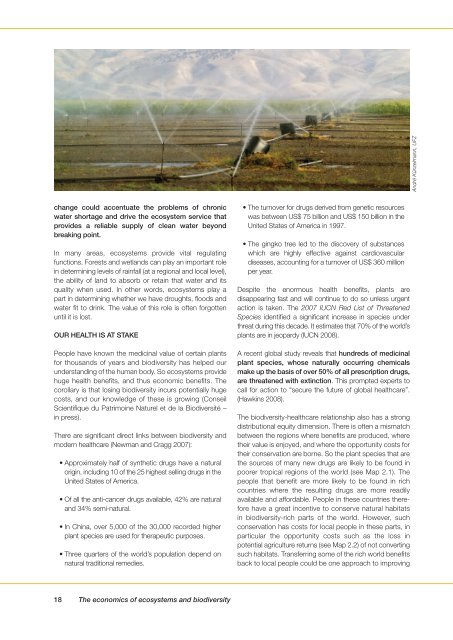Interim Report - TEEB
Interim Report - TEEB
Interim Report - TEEB
Create successful ePaper yourself
Turn your PDF publications into a flip-book with our unique Google optimized e-Paper software.
André Künzelmann, UFZ<br />
change could accentuate the problems of chronic<br />
water shortage and drive the ecosystem service that<br />
provides a reliable supply of clean water beyond<br />
breaking point.<br />
In many areas, ecosystems provide vital regulating<br />
functions. Forests and wetlands can play an important role<br />
in determining levels of rainfall (at a regional and local level),<br />
the ability of land to absorb or retain that water and its<br />
quality when used. In other words, ecosystems play a<br />
part in determining whether we have droughts, floods and<br />
water fit to drink. The value of this role is often forgotten<br />
until it is lost.<br />
OUR HEALTH IS AT STAKE<br />
People have known the medicinal value of certain plants<br />
for thousands of years and biodiversity has helped our<br />
understanding of the human body. So ecosystems provide<br />
huge health benefits, and thus economic benefits. The<br />
corollary is that losing biodiversity incurs potentially huge<br />
costs, and our knowledge of these is growing (Conseil<br />
Scientifique du Patrimoine Naturel et de la Biodiversité –<br />
in press).<br />
There are significant direct links between biodiversity and<br />
modern healthcare (Newman and Cragg 2007):<br />
• Approximately half of synthetic drugs have a natural<br />
origin, including 10 of the 25 highest selling drugs in the<br />
United States of America.<br />
• Of all the anti-cancer drugs available, 42% are natural<br />
and 34% semi-natural.<br />
• In China, over 5,000 of the 30,000 recorded higher<br />
plant species are used for therapeutic purposes.<br />
• Three quarters of the world’s population depend on<br />
natural traditional remedies.<br />
• The turnover for drugs derived from genetic resources<br />
was between US$ 75 billion and US$ 150 billion in the<br />
United States of America in 1997.<br />
• The gingko tree led to the discovery of substances<br />
which are highly effective against cardiovascular<br />
diseases, accounting for a turnover of US$ 360 million<br />
per year.<br />
Despite the enormous health benefits, plants are<br />
disappearing fast and will continue to do so unless urgent<br />
action is taken. The 2007 IUCN Red List of Threatened<br />
Species identified a significant increase in species under<br />
threat during this decade. It estimates that 70% of the world’s<br />
plants are in jeopardy (IUCN 2008).<br />
A recent global study reveals that hundreds of medicinal<br />
plant species, whose naturally occurring chemicals<br />
make up the basis of over 50% of all prescription drugs,<br />
are threatened with extinction. This prompted experts to<br />
call for action to “secure the future of global healthcare”.<br />
(Hawkins 2008).<br />
The biodiversity-healthcare relationship also has a strong<br />
distributional equity dimension. There is often a mismatch<br />
between the regions where benefits are produced, where<br />
their value is enjoyed, and where the opportunity costs for<br />
their conservation are borne. So the plant species that are<br />
the sources of many new drugs are likely to be found in<br />
poorer tropical regions of the world (see Map 2.1). The<br />
people that benefit are more likely to be found in rich<br />
countries where the resulting drugs are more readily<br />
available and affordable. People in these countries therefore<br />
have a great incentive to conserve natural habitats<br />
in biodiversity-rich parts of the world. However, such<br />
conservation has costs for local people in these parts, in<br />
particular the opportunity costs such as the loss in<br />
potential agriculture returns (see Map 2.2) of not converting<br />
such habitats. Transferring some of the rich world benefits<br />
back to local people could be one approach to improving<br />
18 The economics of ecosystems and biodiversity

















